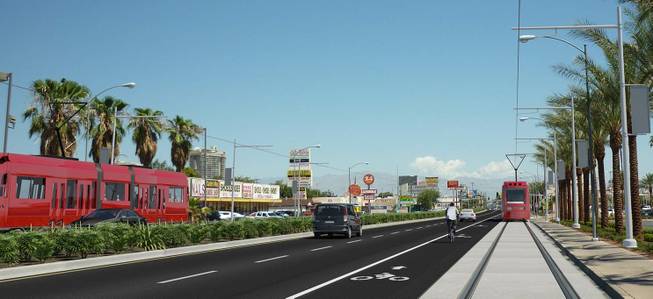
Regional Transportation Commission
A proposal to build an urban light rail or bus rapid transit system on Maryland Parkway between McCarran International Airport and downtown Las Vegas is moving forward. This image from the Regional Transportation Commission shows a version of the proposal that involves running light rail lines down both sides of the street.
Friday, Feb. 8, 2019 | 2 a.m.
View more of the Sun's opinion section
For Southern Nevada residents who may be on the fence about whether to support development of light rail, the Brookings Institution’s Adie Tomer offered some compelling food for thought during a visit to UNLV this week.
In an interview with the Sun, Tomer said the Las Vegas Valley’s decision on light rail has implications that go far beyond transportation. He described how it would affect how our area grows and, subsequently, what that would mean for our quality of life.
If Las Vegas, Henderson and North Las Vegas keep sprawling outward, as they always have, Tomer said, residents can expect longer and longer commutes as more cars crowd onto more miles of roadways.
“All you have to do is go over to Southern California to see the logical endgame of this,” he said. “If you build out everything, what you get is 2 ½-hour drive times.
“Now, I’m not saying you’re going to be LA in 20 years,” he added. “But you’re growing nicely. And very quickly, it’s going to become obvious that the geometry of the place will not work if we go out. It just makes everything farther and farther apart.”
The logical solution is to grow upward, not necessarily in the form of skyscrapers but in more multistory residential buildings.
And that’s where light rail comes in. Not only does it move a lot of people efficiently, but light rail systems are proven to drive both residential and commercial development — including exactly the kind of multistory housing that offers an antidote to sprawl and torturous commutes.
So light rail and efficient growth go hand in hand. And in turn, quality of life is affected in the form of commuting time.
It requires an investment, no doubt. The cost estimate for the proposed system connecting Maryland Parkway with downtown Las Vegas and the medical district is $750 million.
But there’s also a price to pay for continuing to grow out, Tomer argues.
“What we’re left with is the same decision we have today: Do we want to endlessly grow outward and take on the costs of that, or do we want to grow upward and deal with the sacrifices of that?” he said.
Tomer further said that communities that question are effectively choosing sprawl.
“Most places don’t want to have that debate,” he said. “That creates a vacuum of power. And who fills it — and I want to make it clear here that there are no devils in this — are land developers.”
But won’t automated vehicles ease traffic problems, as some opponents of light rail suggest?
Tomer says no. Cars take up space regardless of whether they’re driven by a person or by a computer, he argues, so they’re not the answer to congestion. And while one scenario involving automated vehicles has fewer Americans owning their own cars in favor of using services that provide self-driving vehicles, Tomer doesn’t see that coming to fruition. He doesn’t think it’s feasible that the services could reliably provide Americans with the immediate service they would undoubtedly demand.
“There aren’t going to be cars just waiting all the time, so people are going to have to wait 10, 15 minutes to be picked up,” he said. “And what about the American psyche suggests we like waiting for anything?”
It should be noted here that Tomer doesn’t have skin in this game. He lives in Cleveland, and his thoughts on light rail in the valley are based on his expertise and research as opposed to any personal stake. Tomer is part of Brookings’ Metropolitan Infrastructure Initiative and specializes in such areas as transportation, urban planning and growth management.
His visit to UNLV came at an interesting time, coinciding with the Regional Transportation Commission’s announcement that it was seeking input from local residents on mass transit options for the Maryland Parkway corridor. The light rail proposal is among those options.
Where the community will line up on the issue is anybody’s guess.
But as Tomer’s insight shows, the choice will have ramifications stretching well beyond the central part of the valley.
